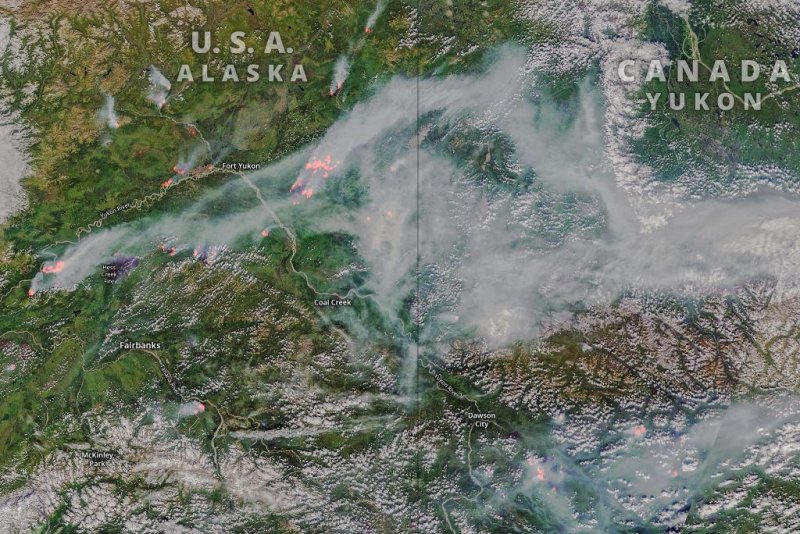NASA satellites have documented numerous wildfires burning in Alaska and Canada's Yukon Territory. Photo by Aqua and Terra MODIS data through NASA Worldview, processed by Pierre Markuse/
Flickr
July 25 (UPI) -- Wildfires are raging across the Arctic as warm, dry conditions persist across the region. Satellite images have revealed wildfires burning in Alaska, Greenland and throughout Siberia.
Summer fires aren't unusual in the Arctic, but scientists estimate the magnitude of this season's burn is greater than any other in the 16-year-record. Fires are burning farther north, and scientists worry the forest fires are igniting peat fires.
Whereas an Arctic forest fire typically lasts just a few hours or days, peat fires, which burn deep into the ground, can last weeks.
Peat also stores large amounts of carbon. As the Arctic's fires continue to burn, record amounts of CO2 are being released into the atmosphere.
According to Mark Parrington, senior scientists with Europe's Copernicus Atmosphere Monitoring Service, the Arctic's fires have released approximately 100 megatons, 100 million metric tons, of CO2 since June -- a total Parrington said on Twitter "is getting close to 2017 fossil fuel CO2 emissions of Belgium."
Recent studies have detailed the significant carbon sequestration services offered by peat. But as the planet has warmed over the last several decades, more and more frozen peat, or permafrost, has thawed, releasing surprisingly large amounts of carbon.
Now, fires are burning that stored carbon, releasing CO2 into the atmosphere.
"The amount of CO2 emitted from Arctic Circle fires in June 2019 is larger than all of the CO2 released from Arctic Circle fires in the same month from 2010 through to 2018 put together," Thomas Smith, an assistant professor in environmental geography at the London School of Economics, told USA TODAY.
Even if much of the peat in burning regions remains untouched by the fire, the burned forest will leave the peat exposed to direct sunlight for years to come, increasing the odds of thawing permafrost.
In addition to releasing carbon, the unprecedented Arctic fires could have other negative environmental impacts. Smoke from the fires as stretched across a large swath of Asia.
"Depending on how long it remains, it may have ecological consequences -- for example, smoke this thick prevents the sunlight to reach the surface in the quantities needed for normal photosynthesis processes to occur," Santiago Gasso, a NASA research scientist, told Australia's ABC News. "The smoke not only blocks the Sun but also absorbs light, warming up an area of the atmosphere that otherwise would have been cooled, exacerbating climate change."















